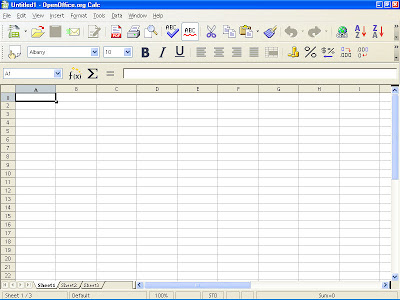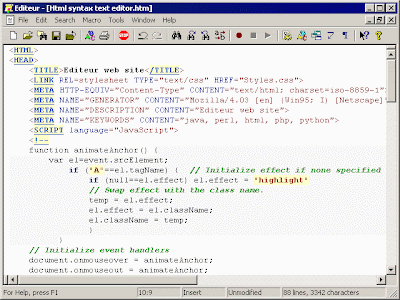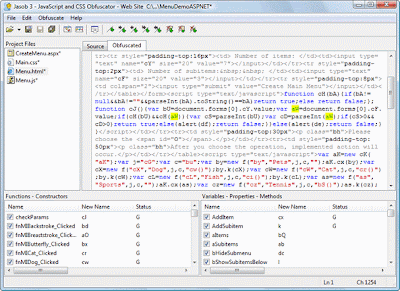Graphical User Interface (GUI)
A Graphical user interface is a human user interface that uses windows, icons and menus and which can be manipulated by a mouse. It is also a computer program designed to allow a computer user to interact easily with the computer typically by making choices from menus or group of icons. Graphical user interface are usually accessed through a pointing device such as a mouse, pen or stylus. All programmes running under a graphical user interface use a consistent set of graphical elements so that once a user learns a particlar interface, he or she can use all programmes without learning additional or new commands.
Word Processor
A word Processor, or word processing program, does exactly what the name implies. It processes words. It also processes paragraphs, pages and entire papers. A type of software that displays characters based on a user's input on an external or internal keyboard. The software allows the user to edit, modify, and format documents, based on display prefences.
Spreadsheet
A spreadsheet is a document which helps you organize data in rows and cllumns in cells. Each cell contains words, a number or a formula. A formula does calculation with the numbers in other cells. By this, you can make charts and graphs automatically.
DBMS
Stands for "Database Management System." In short, a DBMS is a database program. Technically speaking, it is a software system that uses a standard method of cataloging, retrieving, and running queries on data. The DBMS manages incoming data, organizes it, and provides ways for the data to be modified or extracted by users or other programs.
Web Authoring
A website development system that allows web pages to be visually created like a desktop publishing program. It generates the required HTML code for the pages and is able to switch back and forth ( in varying degrees ) between the page layout and the HTML. At a high level, the software is judged by its GUI ( Graphical User Interface ) tools used for designing the page. At a low level, the clarity of HTML code that is generated determines how easily people can modify and maintain the site.
Audio Editing Software
It is a computer application for manipulating sounds or audio. The audio can be used to change tones and sound lengths to different pitches and tones. Examples of audio editing softwares are Audacity and MEF. Audio editing softwares are popularly used in the music industry by recording artists or musicians.
Bitmap Image
Bitmap images are also called raster or paint images. Bitmap images are made up of dots called pixels (picture elements) that are arranged and colored to form a picture or image. When zoomed in, squares can be seen making up the total image. When working with Bitmap images, you can refine small details, make drastic changes or intensify effects.
Desktop Publishing Program
Desktop publishing programs are softwares used to create visual communication design for printing such as newspapers or magazines or on-screen visual publishing. Main programs used are such as Adobe, Corel, Quark and Serif. It low-cost an easy to use which is why it is so popular especially in the fields of advertising. This program can also be used for web-design, making greeting cards and also calendars.
HTML Editor
HTML editor is an authoring software program used to create content for websites. When designing web pages, you need editor features that are easy to use and understand so HTML editor software has management features whereby it creates templates for business or personal use. HTML editor is also good for creating tables, borders around images or changing background color quickly and easily.
Image Editor
Image editor is a graphics program used to that provides a variety of features used for altering bitmapped images such as scanned photos. Image editors also has features that allow you to create or superimpose layers. Examples of image editor programs include Adobe Photoshop and Aviary.
Multimedia
Multimedia is the use of computers to present animation, audio, video, text and graphics in an integrated way. People use multimedia for business or personal use such as presentations or advertisements.
Vector Image
Vector images are collections of individual objects rather than picture elements. Vector images can be composed by points connected by lines. Examples of vector image softwares include Adobe Illustrator, Corel Draw and Macromedia Freehand. Their file formats are usually EPS (Encapsulated Postscript) and PDF (Portable Document Format).
Intro to Information Technology
Wednesday, 11 May 2011
The Internet, The Web and Electronic Commerce
URL
URL stands for Uniform Source Locator. URL is used to locate a network a network resource on the internet. Network resource are files that can be plain web pages, programs or graphics. The URL consists of three parts which are network protocol, host name or address and file or resource location.
HTML
HTML is a computer language used to create websites. It is relatively easy to learn whereby most people could do up in a single seating and also quite powerful in what it allows you to create. HTML stands for Hypertext Markup Language. Hypertext is a method to move around the internet which uses hyperlinks whereby clicking on it allows you to move to the stated page. Markup is what HTML tags do to the text inside them such as being Italic and it is a Language as it has code-words or syntax like any other language.
Javascript
A scripting language developed by Netscape in order to make interactive websites. Javascript can interact with HTML source codes thus enabling the web authors to develop better sites with more dynamic content. Javascript is an open language whereby anyone can use it without purchasing a license.
Applets
Applets are programs written in the Java programming language that can be in HTML pages. If you were to view a Java-enabled browser that contains applets, the applet's code is transferred and decoded using a Java Virtual Machine.
Blogs
Blogs are personal internet journals which are usually frequently updated and written in a personal tone. For example, the writer or "bloggers" often write their observations of the world and also include useful websites relating to it. Different bloggers write different theme such as a writer for a newspaper or columnist but with no specialized training necessary.
Wikis
The term "wiki" comes from the Hawaiian word for "fast". Wiki are websites whereby anyone with access to it can modify it quickly and easily. Wiki websites usually have an "Edit" button.
FTP
FTP stands for File Transfer Protocol. FTP allows you to transfer files between two computers on the internet. The FTP "client" initiates a connection with the FTP "server" thus enabling files to be transferred. The server acts a host so clients need proper authorization such as usernames or passwords before they can choose to send or receive files with other computers connected to the host or server.
Plug-ins
Plug-ins are software or hardware modules that add a specific feature or service to a larger system. Basically, the software simply plugs-in to an existing system. Plug-ins are usually based on MIME file types.
Filters
Filters are software programs designed to protect the computer system. Filters are important for those who have internet access as they help prevent computer viruses steal personal information or parents can use filters to keep children away from explicit content.
URL stands for Uniform Source Locator. URL is used to locate a network a network resource on the internet. Network resource are files that can be plain web pages, programs or graphics. The URL consists of three parts which are network protocol, host name or address and file or resource location.
HTML
HTML is a computer language used to create websites. It is relatively easy to learn whereby most people could do up in a single seating and also quite powerful in what it allows you to create. HTML stands for Hypertext Markup Language. Hypertext is a method to move around the internet which uses hyperlinks whereby clicking on it allows you to move to the stated page. Markup is what HTML tags do to the text inside them such as being Italic and it is a Language as it has code-words or syntax like any other language.
Javascript
A scripting language developed by Netscape in order to make interactive websites. Javascript can interact with HTML source codes thus enabling the web authors to develop better sites with more dynamic content. Javascript is an open language whereby anyone can use it without purchasing a license.
Applets
Applets are programs written in the Java programming language that can be in HTML pages. If you were to view a Java-enabled browser that contains applets, the applet's code is transferred and decoded using a Java Virtual Machine.
Blogs
Blogs are personal internet journals which are usually frequently updated and written in a personal tone. For example, the writer or "bloggers" often write their observations of the world and also include useful websites relating to it. Different bloggers write different theme such as a writer for a newspaper or columnist but with no specialized training necessary.
Wikis
The term "wiki" comes from the Hawaiian word for "fast". Wiki are websites whereby anyone with access to it can modify it quickly and easily. Wiki websites usually have an "Edit" button.
FTP
FTP stands for File Transfer Protocol. FTP allows you to transfer files between two computers on the internet. The FTP "client" initiates a connection with the FTP "server" thus enabling files to be transferred. The server acts a host so clients need proper authorization such as usernames or passwords before they can choose to send or receive files with other computers connected to the host or server.
Plug-ins
Plug-ins are software or hardware modules that add a specific feature or service to a larger system. Basically, the software simply plugs-in to an existing system. Plug-ins are usually based on MIME file types.
Filters
Filters are software programs designed to protect the computer system. Filters are important for those who have internet access as they help prevent computer viruses steal personal information or parents can use filters to keep children away from explicit content.
Sunday, 17 April 2011
Careers in Information Technology
Webmaster

A person whose occupation is designing, developing, marketing, creates and manages the information content such as words and pictures of a web site especially for a company or a organization. Besides that, a webmaster's job is also to manage the computer server and technical programming aspects of a web site. A webmaster would also need to ensure HTML validity and link facility.
Computer Support Specialist

A computer support specialist attends to users who are having problems with software, word processing, operating systems, programming languages, including printing or electronic e-mail. Some assist companies while others provide support in-house to corporate and answer clients inquiries concerning any difficulties. Computer Support Specialist is also known as technical support specialist.
Technical Writer

Technical Writers explain in simple language, scientific and technical ideas that are difficult for the average readers to understand. Technical Writers create useful documents such as online help, user guides, white papers, design specifications, system manuals, and other documents. Technical writers can be found in engineering, physics, chemistry, biology, medicine, technology, and an assortment of other industries.
Software Engineer

A software engineer is in charge of assembling extensive amounts of code into working applications and also updating and fixing problems in an existing software. A software engineer is also referred to as a programmer, because the main duties of a software engineer is programming computers.
Network Administrator

A computer programmer designs software programs through building logical work flow charts in which it translates into a language that computers can understand. In the majority of cases, the computer programmer also designs a graphical user interface so that non-technical users can run the software through easy, point-and-click, menu-oriented modules.
A person whose occupation is designing, developing, marketing, creates and manages the information content such as words and pictures of a web site especially for a company or a organization. Besides that, a webmaster's job is also to manage the computer server and technical programming aspects of a web site. A webmaster would also need to ensure HTML validity and link facility.
Computer Support Specialist
A computer support specialist attends to users who are having problems with software, word processing, operating systems, programming languages, including printing or electronic e-mail. Some assist companies while others provide support in-house to corporate and answer clients inquiries concerning any difficulties. Computer Support Specialist is also known as technical support specialist.
Technical Writer
Technical Writers explain in simple language, scientific and technical ideas that are difficult for the average readers to understand. Technical Writers create useful documents such as online help, user guides, white papers, design specifications, system manuals, and other documents. Technical writers can be found in engineering, physics, chemistry, biology, medicine, technology, and an assortment of other industries.
Software Engineer
A software engineer is in charge of assembling extensive amounts of code into working applications and also updating and fixing problems in an existing software. A software engineer is also referred to as a programmer, because the main duties of a software engineer is programming computers.
Network Administrator
Network administrators are professionals who are in charge of maintaining a computer network. The administrator will install and maintain any hardware and also oversee installation and updates to any software needed to operate the network. It is not unusual for a network administrator to be consulted whenever upgrades in hardware or software are required to create a new network or enhance an existing one. Database Administrator The main responsibility of a database administrator involves the installation of new databases. As part of the database installation, the database administrator will set up login credentials to authorized personel, define the privileges associated with each authorized user, and ensure that every work station attached to the network is set up to access the new database easily and more efficient. System Analyst The role of a system analyst is to get computers in a company’s system to work together. They would connect all computers together through a network and would analyze how they would be able to transfer data from one computer to another. This process would require a lot of research and data of which systems analysts are able to get from the internet. Programmer |
A computer programmer designs software programs through building logical work flow charts in which it translates into a language that computers can understand. In the majority of cases, the computer programmer also designs a graphical user interface so that non-technical users can run the software through easy, point-and-click, menu-oriented modules.
Subscribe to:
Comments (Atom)




















